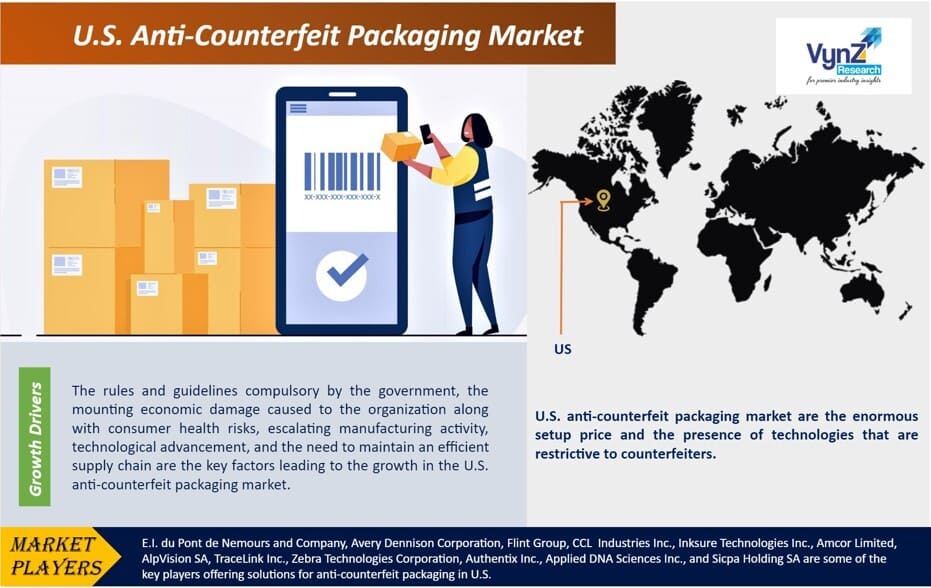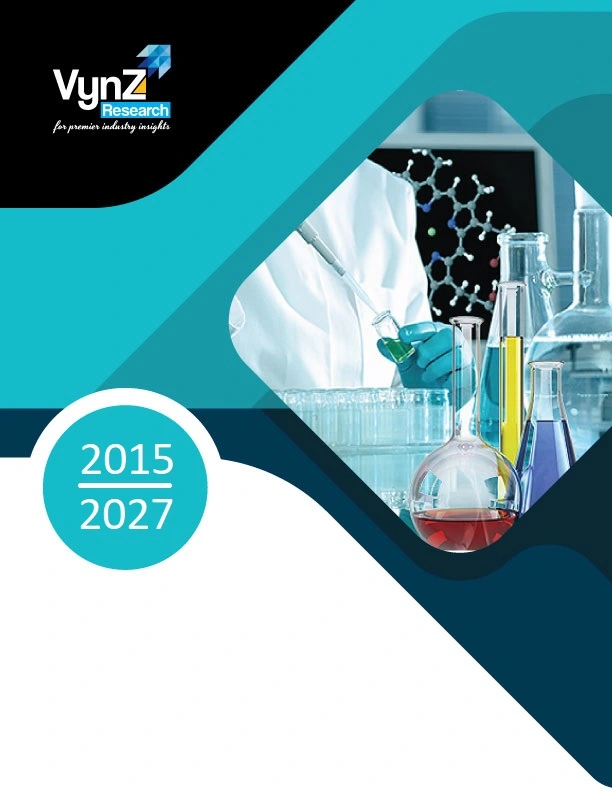Industry Overview
The U.S. anti-counterfeit packaging market will grow to USD 16.7 billion at a CAGR of 9.8% during the forecast period ranging from 2025 to 2030.
Anti-counterfeit packaging refers to the specific measures integrated into product packaging. It is done to prevent counterfeiting and illegal imitation. These solutions typically use different technologies such as holograms, RFID tags, unique serialization, and tamper-evident features. These features help in the verification of product authenticity and also help protect brands from fraud. Anti-counterfeit packaging is crucial in specific type of industries such as pharmaceuticals, luxury goods, and electronics to ensure consumer safety, brand reputation, and product integrity.
The growth of the U.S. anti-counterfeit packaging market is attributed to the rising awareness among consumers and businesses about the risks associated with counterfeit products, strict regulations in specific industries like pharmaceuticals and food & beverages, continuous innovation in anti-counterfeit technologies, increasing international trade and the globalization of supply chains, and rising efforts by brands to protect their intellectual property rights and maintain consumer trust.
The cost of setup is a key factor hindering the growth of the U.S. anti-counterfeit packaging market. Opportunities for growth to the market is however offered by the significant innovation and development in anti-counterfeit technologies that enhance product traceability and authentication.

U.S. Anti-Counterfeit Packaging Market Segmentation
Insight by Technology
The U.S. anti-counterfeit packaging market is divided by technology into covert, forensic, overt, and track & trace segments. Out of these segments, the track & trace segment is expected to hold the largest share in the market during the forecast period mainly due to lower technological complications.Out of its different subsections such as radio-frequency identification (RFID), machine-readable data, and others, the RFID segment will account for the largest share in the marketdue to higher product security and better tracking features. On the other hand, the covert segment, which is further subdivided into security labels, invisible printing, and other sections, will witness a significant growth in the invisible printing segmentdue to higher requirement from the security and pharmaceutical applications.
Insight by Application
The U.S. anti-counterfeit packaging market is divided by application into pharmaceutical & healthcare, food & beverage, clothing & apparel, and other segments. Out of them, the pharmaceutical & healthcare category will accountfor the largest share in the market during the forecast period due to higher demand to handle the growing health concerns among the people as well as the growing requirement for product differentiation and labeling for their authentication along with a significant rise in pharmaceutical production.
Insight by Product Type
The U.S. anti-counterfeit packaging market is divided by type of products being protected into pharmaceuticals, electronics, cosmetics, and food & beverages. Out of these segments, the pharmaceuticals category is expected to grow more during the forecast period due to strict regulatory requirements for drug safety and to mitigate the risks of counterfeit products affecting public health.
Insight by EndUser
The U.S. anti-counterfeit packaging market is divided by endusers into manufacturers, brand owners, retailers, and consumers. Out of these segments, the retailers’segment is likely to grow at a higher CAGR due to widespread demand for secure packaging solutions.
Insight by Material Used
The U.S. anti-counterfeit packaging market is divided by materials used into plastics, paper & paperboard, glass, and metals segments. Out of these segments, the plastics category is projected to grow at a higher CAGR during the forecast period mainly due to their higher flexibility in integrating progressive anti-counterfeit technologies and cost-effectiveness in manufacture.
Insight by Distribution Channel
The U.S. anti-counterfeit packaging market is divided by the different distribution channels through which products are sold into retail stores, online platforms, pharmacies, and specialty stores. Out of them, the online platforms segment is anticipated to grow at a higher CAGR faster due to the rapid growth of e-commerce and the growing requirement for strong anti-counterfeit measures to protect the products sold online from imitators.
U.S. Anti-Counterfeit Packaging Market Report Coverage
|
Report Metric
|
Details
|
|
Historical Period
|
2018 - 2023
|
|
Base Year Considered
|
2024
|
|
Forecast Period
|
2025 - 2030
|
|
Market Size in 2024
|
U.S.D. XX Billion
|
|
Revenue Forecast in 2030
|
U.S.D. 16.7 Billion
|
|
Growth Rate
|
9.8%
|
|
Segments Covered in the Report
|
By Technology, By Application, By Product Type, By End-User, By Material Used and By Distribution Channel
|
|
Report Scope
|
Market Trends, Drivers, and Restraints; Revenue Estimation and Forecast; Segmentation Analysis; Impact of COVID-19; Companies’ Strategic Developments; Market Share Analysis of Key Players; Company Profiling
|
|
Regions Covered in the Report
|
US
|
Industry Dynamics
U.S. Anti-Counterfeit Packaging Market Growth Drivers
The rules and guidelines compulsory by the government, the mounting economic damage caused to the organization along with consumer health risks, escalating manufacturing activity, technological advancement, and the need to maintain an efficient supply chain are the key factors leading to the growth in the U.S. anti-counterfeit packaging market.
Owing to the mounting alertness about the importance of brand protection among companies has resulted, in escalating concern regarding counterfeit products which further increases the demand for anti-counterfeit packaging in the U.S. Some of the other key factors driving the growth of the industry are remote authentication of products, robust development in the demand from the food & beverage and pharmaceutical & healthcare sectors, and surge in the emphasis of manufacturers on brand protection.
U.S. Anti-Counterfeit Packaging Market Challenges
Key factors hindering the growth of the U.S. anti-counterfeit packaging market are the enormous setup price and the presence of technologies that are restrictive to counterfeiters.
U.S. Anti-Counterfeit Packaging Market Competitive Insight
Market players in the anti-counterfeit packaging industry are investing capital to develop technologically advanced systems.
E.I. du Pont de Nemours & Co is a diversified chemical company operating in more than 80 countries. Its massive portfolio includes agriculture, feed and nutrition, electronics and communication, construction and transportation, and safety and protection. DuPont has tried to move into more specialized products. The company has also increased its research into genetically modified seed technologies, making it one of the most prominent global seed providers.
Avery Dennison Corp (Avery Dennison) is a provider of labeling and packaging materials and solutions. It produces pressure-sensitive materials, tags, labels, tickets, and other converted products. Avery Dennison also manufactures and sells fasteners, tickets, tags, radio-frequency identification (RFID) inlays and tags, and imprinting equipment, and related services.
E.I. du Pont de Nemours and Company, Avery Dennison Corporation, Flint Group, CCL Industries Inc., Inksure Technologies Inc., Amcor Limited, AlpVision SA, TraceLink Inc., Zebra Technologies Corporation, Authentix Inc., Applied DNA Sciences Inc., and Sicpa Holding SA are some of the key players offering solutions for anti-counterfeit packaging in U.S.
Recent Developments by Key Players
Flint Group (a global leader in printing and packaging inks and coatings) collaborated with Heidelberg Japan KK (Heidelberg). This partnership will oversee the local distribution of dayGraphica products on behalf of Flint Group.
Amcor, a global leader in developing and producing responsible packaging solutions, has expanded its packaging innovation hubs around the world. In addition to existing centers in the US, South America and Asia Pacific, the company has now opened its Amcor Innovation Center Europe (AICE) in Ghent, Belgium. The AICE will pioneer new material technologies to make packaging more sustainable and performant, while focusing on designs that stand out in shops and increase ease-of-use for consumers.
Primary Research Interviews - Breakdown
.png)




.png)